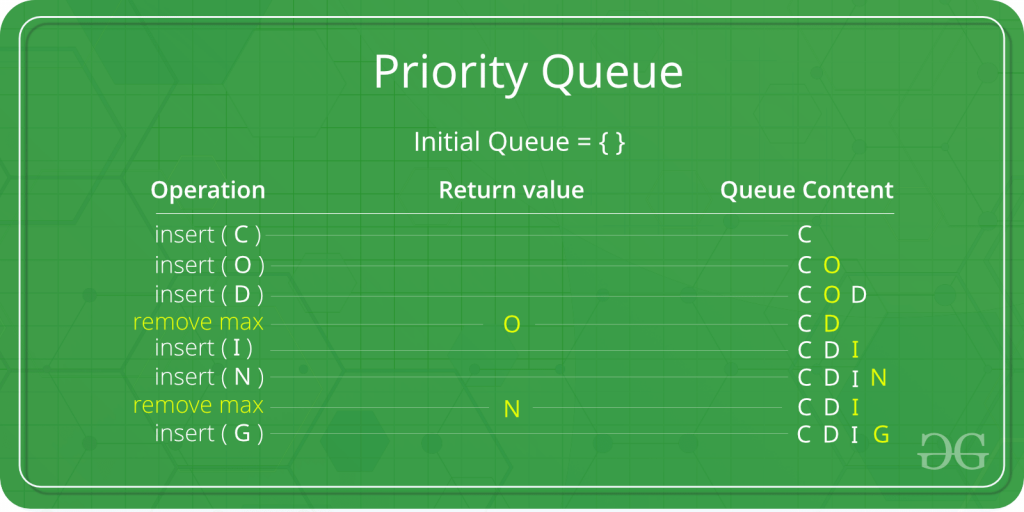In the world of data structures, queues play a critical role in managing and processing data efficiently. Among the various types of queues, priority queues and circular queues stand out due to their unique characteristics and specific use cases. Understanding these two types of queues—how they function, their advantages, and their applications—can significantly enhance your ability to implement efficient algorithms and optimize performance in software development.
What is a Priority Queue in Data Structure?
A priority queue in data structure is a special type of queue where each element is associated with a priority. The order of elements in the priority queue is determined not by the order in which they arrive but by their priority. Elements with higher priorities are dequeued before elements with lower priorities. If two elements have the same priority, they are dequeued according to their order in the queue.
Key Characteristics of Priority Queues:
-
Priority-Based Processing: Elements are processed based on priority, making it ideal for situations where certain tasks must be prioritized.
-
Dynamic Changes: Priorities can be dynamically changed, allowing for flexible management of elements.
-
Implementation: Priority queues are typically implemented using heaps, binary search trees, or other data structures that allow efficient priority-based access.
Applications of Priority Queues
Priority queues are widely used in scenarios where prioritization of tasks is crucial. Some common applications include:
-
Job Scheduling: In operating systems, priority queues manage processes by their priority, ensuring that critical tasks are executed first.
-
Graph Algorithms: Algorithms like Dijkstra’s shortest path and Prim’s minimum spanning tree utilize priority queues for efficient computation.
-
Event Simulation: In simulations, events are processed in order of their occurrence time, managed by priority queues.
What is a Circular Queue in Data Structure?
A circular queue in data structure, also known as a ring buffer, is a linear data structure that follows the FIFO (First In, First Out) principle but connects the end of the queue back to the front, forming a circle. This allows efficient use of space by reusing memory locations when elements are dequeued.
Key Characteristics of Circular Queues:
-
Fixed Size: Circular queues have a fixed maximum size, set at the time of creation.
-
Efficient Use of Space: By reusing empty slots, circular queues avoid the “false overflow” problem that occurs in linear queues when the rear reaches the end of the array.
-
Pointers: Circular queues use two pointers, front and rear, to track the start and end of the queue, wrapping around when they reach the end.
Applications of Circular Queues
Circular queues are particularly useful in situations where memory efficiency and continuous looping are required. Some common applications include:
-
Buffer Management: Circular queues manage buffers in network routers and switches, ensuring efficient handling of incoming and outgoing data packets.
-
Resource Management: In embedded systems, circular queues manage limited resources, like buffering audio/video streams or handling cyclic data.
-
Task Scheduling: In real-time systems, circular queues help manage periodic tasks that need to be executed in a fixed sequence repeatedly.
Comparing Priority Queues and Circular Queues
Usage Contexts
-
Priority Queues: Best suited for applications where prioritization is crucial. For instance, in emergency response systems, tasks like dispatching ambulances need to be handled based on urgency.
-
Circular Queues: Ideal for situations requiring efficient memory use and cyclic data processing. For example, in multimedia applications, circular queues manage continuous streams of data without wastage.
Performance Considerations
-
Priority Queues: Performance depends on the underlying data structure. Heaps provide O(log n) complexity for insertion and deletion, making them efficient for managing dynamic priority-based tasks.
-
Circular Queues: Offer O(1) complexity for insertion and deletion operations, providing consistent performance for applications with fixed-size data and cyclic patterns.
Implementing Priority Queues and Circular Queues
Implementing a Priority Queue
A common way to implement a priority queue is using a binary heap, where the highest (or lowest) priority element is always at the root.
python
Copy code
import heapq
class PriorityQueue:
def __init__(self):
self.heap = []
def push(self, item, priority):
heapq.heappush(self.heap, (priority, item))
def pop(self):
return heapq.heappop(self.heap)[1]
def is_empty(self):
return len(self.heap) == 0
Implementing a Circular Queue
A simple implementation of a circular queue uses a fixed-size list and two pointers.
python
Copy code
class CircularQueue:
def __init__(self, size):
self.queue = [None] * size
self.max_size = size
self.front = -1
self.rear = -1
def enqueue(self, item):
if (self.rear + 1) % self.max_size == self.front:
raise Exception(“Queue is full”)
if self.front == -1:
self.front = 0
self.rear = (self.rear + 1) % self.max_size
self.queue[self.rear] = item
def dequeue(self):
if self.front == -1:
raise Exception(“Queue is empty”)
item = self.queue[self.front]
if self.front == self.rear:
self.front = self.rear = -1
else:
self.front = (self.front + 1) % self.max_size
return item
def is_empty(self):
return self.front == -1
Conclusion
Understanding the differences between priority queues and circular queues, along with their appropriate use cases, is vital for efficient algorithm design and implementation. A priority queue in data structure excels in scenarios demanding prioritized task management, while a circular queue in data structure is perfect for cyclic data handling and memory-efficient operations. By leveraging the strengths of these data structures, developers can create robust and performant applications tailored to their specific needs.




